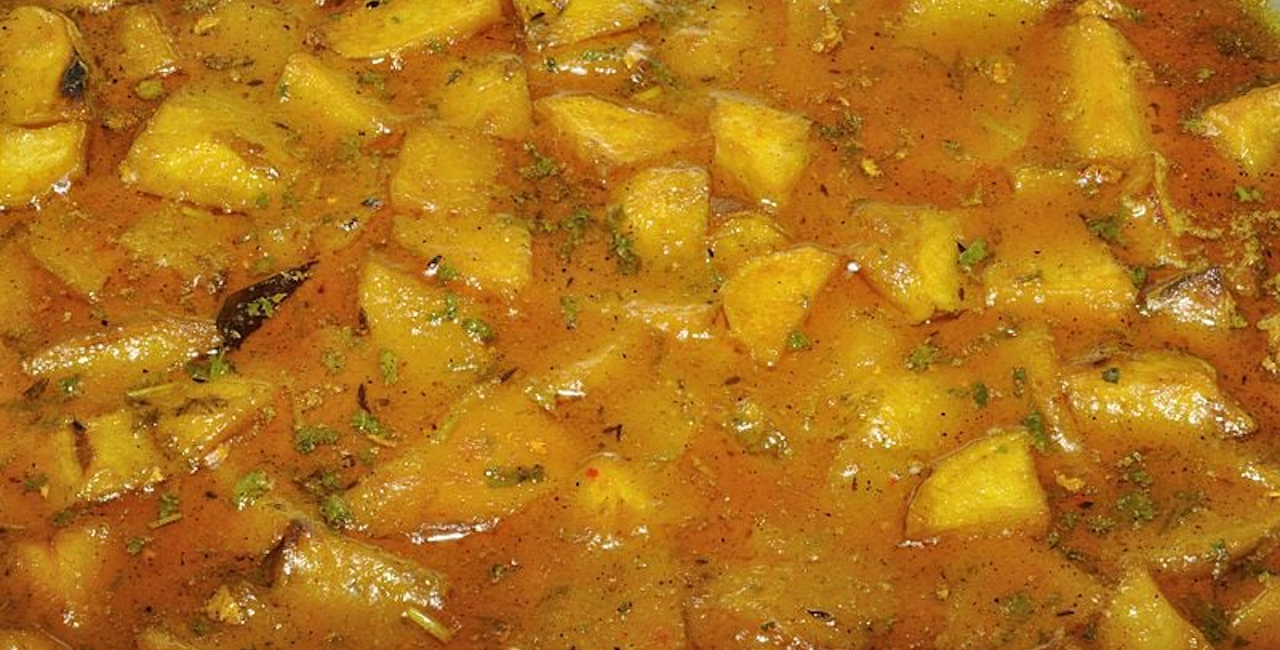Currently Empty: ₹0.00

Aloo ka Jhol, a beloved dish from the Kumaon and Garhwal regions of Uttarakhand, is a simple yet flavorful potato curry. Prepared with a mix of aromatic spices, this dish embodies the warmth of home-cooked meals in the Himalayan hills. Aloo ka Jhol, meaning “potatoes in a thin gravy,” is enjoyed as a staple in Uttarakhand’s homes, especially during chilly weather or festive gatherings. This traditional dish offers a glimpse into the unique culinary traditions of Uttarakhand, where food is both wholesome and deeply rooted in local ingredients and culture.
1. The Origins of Aloo ka Jhol
Uttarakhand’s cuisine is known for its simplicity and reliance on locally grown produce, and Aloo ka Jhol is no exception. The use of humble ingredients like potatoes, tomatoes, and mild spices reflects the essence of Pahari (mountain) cuisine. While the region’s mountainous terrain makes it difficult to cultivate a wide variety of vegetables, potatoes thrive in the climate, making them a common ingredient in local recipes. Aloo ka Jhol, in particular, showcases how locals create satisfying and nutritious meals from basic ingredients.
2. Ingredients and Preparation
The ingredients for Aloo ka Jhol are straightforward and commonly available, making it an easy dish to prepare. The key ingredients include potatoes, tomatoes, green chilies, ginger, garlic, turmeric, cumin seeds, and mustard oil. Each of these elements adds a layer of flavor to the dish, contributing to its distinctive taste.
To make Aloo ka Jhol, potatoes are peeled and chopped into medium-sized chunks and lightly fried to enhance their flavor. The curry’s base is made by tempering cumin seeds in hot mustard oil, followed by adding ginger, garlic, and green chilies. Tomatoes are then added and cooked until they soften, creating a rich base that complements the earthy flavor of the potatoes. Turmeric is used to give the curry a beautiful golden hue, while other spices like coriander powder and a hint of asafoetida (hing) enhance the aroma and flavor.
After the base is ready, the potatoes are added to the mixture, along with water, to achieve a thin, soupy consistency. The curry is then simmered until the potatoes are tender and infused with the flavors of the spices. Fresh coriander leaves are often sprinkled on top before serving, adding a burst of color and freshness.
3. The Role of Mustard Oil
One of the defining characteristics of Aloo ka Jhol is the use of mustard oil, which gives the dish its unique taste and aroma. Mustard oil is a common ingredient in many traditional North Indian dishes, particularly in the Himalayan regions, where its warming properties are appreciated. When heated, mustard oil releases a distinct nutty flavor that pairs well with the spices in Aloo ka Jhol, enhancing the overall depth of the dish.
4. Flavor Profile and Serving Style
Aloo ka Jhol has a rustic and mildly spiced flavor, with the taste of mustard oil and cumin providing a warm, comforting aroma. The thin gravy is light yet satisfying, making it perfect for Uttarakhand’s cold climate. Unlike rich gravies found in other parts of India, Aloo ka Jhol has a soupy consistency that is both hearty and easy to digest.
Traditionally, Aloo ka Jhol is enjoyed with steamed rice, which allows the flavors of the curry to be fully savored. The rice soaks up the thin gravy, creating a wholesome, balanced meal that is both filling and flavorful. Many families in Uttarakhand also enjoy it with bhatt ki dal (black soybeans cooked in a similar soupy style) or with Kumaoni-style rotis (flatbreads).
5. Cultural Significance and Variations
Aloo ka Jhol is not just a dish; it’s an integral part of Uttarakhand’s culinary heritage. The simplicity of Aloo ka Jhol reflects the resourcefulness of the Pahari people, who have developed ways to create delicious meals from limited ingredients. This dish is a staple during family gatherings, religious events, and festivals, where it is prepared as a comfort food that appeals to all ages.
While Aloo ka Jhol is traditionally prepared with minimal spices, variations exist depending on the region and family preferences. Some cooks may add spices like garam masala or red chili powder to make it spicier, while others add yogurt for a tangy twist. However, the basic essence of the dish remains the same – a wholesome, nourishing curry that showcases the flavors of the mountains.
6. Nutritional Benefits
Aside from being delicious, Aloo ka Jhol is also nutritious. Potatoes are a good source of carbohydrates, providing energy, and are rich in fiber, vitamins, and minerals like potassium. The spices used in the curry, such as turmeric and cumin, have their own health benefits; turmeric is known for its anti-inflammatory properties, while cumin aids digestion. The mustard oil used in the recipe is rich in monounsaturated fats and has a high smoke point, making it ideal for cooking in colder climates.
7. How Aloo ka Jhol is Embracing New Audiences
As more people explore regional Indian cuisines, Aloo ka Jhol is gaining recognition beyond Uttarakhand. Chefs and home cooks alike are experimenting with traditional recipes, adding their own twists while preserving the dish’s authenticity. Today, Aloo ka Jhol can be found on the menus of select Indian restaurants and food blogs, showcasing Uttarakhand’s culinary richness to a broader audience.
Conclusion
Aloo ka Jhol embodies the simplicity and flavor of Uttarakhand’s traditional cuisine. It’s a dish that tells the story of a region where food is prepared with love and resourcefulness. Whether you’re savoring it with rice on a cold winter’s day or trying it for the first time, Aloo ka Jhol is sure to leave a lasting impression of Uttarakhand’s warm and rustic culinary heritage.


